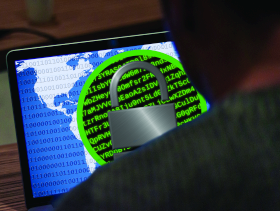

Cybersecurity is not something one usually associates with residential estates, but the threats from cybercriminals apply equally to estates as they do to businesses and the individual homeowner. We have already seen cases where estates are hit with a ransomware attack after someone inadvertently opened an email attachment.
What if something similar happened in your estate? If your access control and administrative systems are on the same network, they could all be infected and/or inaccessible. That means residents won’t be able to come and go easily and any queries, accounts or maintenance schedules will be inaccessible. And what if, in a worst case scenario, the clubhouse it hit and golf schedules are lost?
The answer is, you have to pay the criminals and hope they decrypt your systems and hope even more that they don’t strike again soon, or find some other way to restore backups (which you naturally have). Two cities in Florida, in the USA, were recently hit with ransomware and had to pay to get access to their systems again. One paid a reported 42 bitcoin (about US$ 573 000 at the time), the other 65 bitcoin (about US$ 897 000).
Similarly, the city of Atlanta is shelling out in the region of US$ 17 million to recover from an attack, while the costs to Baltimore are already at over US$ 18 million. And the chance of ever finding the criminals, let alone prosecuting them, is basically zero.
Even worse, the criminals are making small fortunes. One of the more prevalent ransomware variants out there over the past year, named GandCrab, recently announced they are shutting down their efforts and retiring. Their malware, which was provided as a service on the dark web, netted around US$ 2 billion since January 2018 – according to their retirement notice. Of this, about US$ 150 million went to the creators and operators of the service themselves. That’s not a bad retirement nest egg.
How much can you afford?
An estate probably won’t be held ransom for such large amounts of money, but with 1 bitcoin valued at over R 170 000 at the time of writing, do you really want to find out how much it will cost?
Furthermore, all reports show that ransomware attacks are increasing because of the ease with which money is made, as well as the slim chance of ever being caught.
Kaspersky Lab reports that “attacks on urban infrastructure are often worryingly successful, with far reaching impact on essential systems and processes, affecting not just the authority itself but local businesses and citizens. What makes cities a target? It could be the fact that they run vast networks of connected technology that can be hard to update, manage and patch effectively, or because the attackers believe they may be more inclined to pay the ransom to avoid recovery costs that can be many times higher than the ransom fee.”
Large estates in South Africa are really small cities with similar infrastructures and vulnerabilities. They should therefore be taking the same cybersecurity precautions.
Security checklist for your estate
Kaspersky offers the following as a useful checklist to harden your security:
1. Implement security awareness training to teach all staff to treat email attachments, or messages from people they don’t know, with caution.
2. Backup data regularly and ensure you have full visibility of all devices on the network – and ensure they are all protected.
3. At the very least, enhance your security with a free anti-ransomware tool.
4. Carry out regular security audits of your network for anomalies.
5. Don’t overlook less obvious targets, such as queue management systems, POS terminals, and even vending machines. Outdated embedded systems often have old protection, or may not have any protection at all, and they require a solution against modern threats that has been developed taking into account the specific needs and characteristics of such devices.
6. Always use an endpoint security solution that is powered by behaviour detection and able to roll back malicious actions, as well as application control to track malicious activity in legitimate applications. Specialised devices should be in Default Deny mode.
7. In addition to adopting essential endpoint protection, implement a corporate-grade security solution that detects advanced threats on the network level at an early stage, such as Kaspersky Anti Targeted Attack Platform.
8. Provide your security operation team with access to the latest threat intelligence, to keep them up to date with the new tools, techniques and tactics used by threat actors.

© Technews Publishing (Pty) Ltd. | All Rights Reserved.